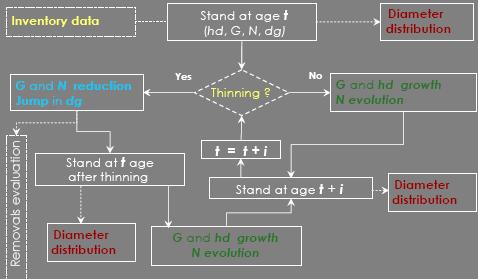ModisPinaster Model
ModisPinaster is a diameter distribution model for Pinus pinaster stands (Model with Diameter Distribution for P. Pinaster), originally developed by Fonseca (2004). It applies to pure maritime pine stands, thinned or unthinned. Stands might be homogeneous in horizontal distribution or having an irregularly shaped diameter distribution.
ModisPinaster was implemented in Capsis platform in June 2009 by F.Coligny and T. Fidalgo Fonseca under COST Action FP0603.
ModisPinaster authors' are T. Fonseca (UTAD, Portugal), C.P. Marques (UTAD, Portugal), B.R. Parresol (USDA Forest Services, USA) and F. Coligny (AMAP, France).
Data used in model development come from the database on maritime pine (Data_Pinaster) created and maintained over the last two decades at the Forestry Department of University of Trás-os-Montes e Alto Douro. Data were collected in North Portugal, more precisely in Tâmega’s Valley stands (latitude range: 41º 15’N – 41º52’N; longitude range: 7º 20’ W – 8º 00’ W).
ModisPinaster is constituted by six components: (i) dominant height growth; (ii) basal area growth; (iii) tree mortality; (iv) diameter distribution; (v) thinning algorithm and (vi) volume or biomass assessment by diameter classes. The relashionship between the components is shown in Figure 1.
Figura 1. ModisPinaster structure.
Major components
Dominant height growth and site index are estimated using Marques (1987) models.
Diameter distribution is modeled by Johnson’s SB (Johnson, 1949), using the 3-parameter recovery approach developed by Parresol (2003).
Evaluation of tree mortality is a two-phase process. In the first phase the model estimates the probabilibity of mortality to occur during the projection period. In a second phase the number of survival trees is calculated for the projection age and then it is adjusted by the probability of mortality to occur. Probability of mortality is predicted by two sub-models, according to the major influences: wind or other causes, these being mainly related to density/competition effects.
Basal area growth is estimated with a growth model that accounts for tree mortality.
The procedure to simulate a thinning requires previous information on diameter distribution (current or simulated using the SB distribution). Trees to be removed from the diameter distribution are identified with a thinning algorithm (Alder 1979) that assumes a probability of survival to cut proportional to trees’ size. Inclusion of ModisPinaster into the Capsis platform extended the original thinning option to allow other selective thinnings (low, high, mixed) with the interactive thinning procedure developed by F. Coligny.
Volume by diameter classe is estimated using the volume (total e percentual) equations from Fonte (2000), and the height-diameter relashionships by Almeida (1999).
Biomass by compartments is estimated using the biomas equations from Lopes (2005). For the quantification of carbon content it was assumed an average value of 47,5% of carbon per kg of dry mass (Lopes e Aranha, 2006).
A synthesis of ModisPinaster development can be found in the document presented at the 11th Meeting of Capsis (Montpellier, 24 June 2009) modispinaster, also available in Capsis documentation, or in the document presented at the University of Helsinki (Finland), 17-18 September 2009, under the 3rd Workshop and MC Meeting of the Cost Action FP0603. An overview of the model with the improvements made in May 2011 is available for download here. pdf
You may see also the tutorial.
References
Alder, D., 1979. A distance-independent tree model for exotic conifer plantations in east Africa. For. Sci. 25: 59-71.
Almeida, L.F.R., 1999. Comparação de metodologias para estimação de altura e volume em povoamentos de pinheiro bravo no Vale do Tâmega. Relatório Final de Estágio. UTAD, Vila Real, 114pp.
Lopes, D., 2005. Estimating Net primary Production in Eucalyptus globulus and Pinus pinaster Ecossytems in Portugal. PhD Thesis, Kingston University, 282p.
Lopes,D. Aranha, J., 2006. Avaliação do Conteúdo de Carbono na Matéria Seca de Diferentes Componentes de Árvores de Eucalyptus globulus e de Pinus pinaster. Silva Lus., 14:149-154.
Fonte, C.M.M., 2000. Estimação do volume total e mercantil em Pinus pinaster Ait. no Vale do Tâmega. Relatório Final de Estágio. UTAD, Vila Real, 95pp.
Fonseca, T.F. 2004. Modelação do crescimento, mortalidade e distribuição diamétrica, do pinhal bravo no Vale do Tâmega. PhD. dissertation, Univ. of Trás-os-Montes e Alto Douro, Vila Real, Portugal. 248 p.
Johnson, N.L. 1949. Systems of frequency curves generated by methods of translation. Biometrika 36: 149-176.
Marques, C. P., 1991. Evaluating site quality of even-aged maritime pine stands in northern Portugal using direct and indirect methods. For. Ecol. Manage. 41: 193-204.
Parresol, B.R. 2003. Recovering parameters of Johnson’s SB distribution. USDA For. Ser. Res. Pap. SRS-31. 9 p.
Additional references
Parresol, B.R., T.F. Fonseca, C.P. Marques, 2010. Numerical details and SAS programs for parameter recovery of the SB distribution. US For. Serv. Gen. Tech. Rep. SRS–122. Southern Res. Stn., Asheville, NC. pdf
Fonseca, T.F., C.P. Marques, B.R. Parresol, 2009. Describing maritime pine diameter distributions with Johnson’s SB distribution using a new all-parameter recovery approach. For. Sci. 55(4):367-373. pdf


